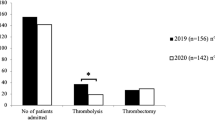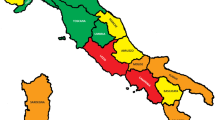Abstract
After recognizing the pivotal role played by stroke unit (SU) admission in reducing mortality and dependency in stroke patients, the need to organize and monitor stroke networks has become an increasingly essential aspect of stroke care. We conducted a retrospective study of stroke patients admitted to hospitals in the Veneto region from 2007 to 2015 in order to evaluate the effectiveness of the stroke pathway and trends over time. Between 2007 and 2015, 61,062 stroke patients were discharged from Veneto hospitals: they were more frequently female, females were older than males, and had higher intrahospital mortality and a lower probability of undergoing systemic thrombolysis. Patients admitted to facilities with a level 2 SU were twice as likely to undergo thrombolytic treatment compared to those admitted to facilities with a level 1 and had a lower intrahospital mortality rate. During the collection period, thrombolytic treatments increased in both level 1 and 2 SUs, as did the number of patients admitted to neurology wards and to facilities with an SU. Our study confirmed that thrombolytic treatment and admission to a facility with an SU are important determinants in improving stroke patient outcome. The increase in the proportion of both SU admissions and thrombolytic treatments demonstrates the effectiveness of the regional hub-and-spoke organization model, suggesting that implementation of highly specialized facilities is an efficient strategy in improving stroke care. The role of the observed sex bias in stroke treatment and outcome needs to be explored.
Similar content being viewed by others
References
Stroke Unit Trialists’ Collaboration (2002) Organised inpatient (stroke unit) care for stroke. Cochrane Database Syst Rev 1:CD000197
Jauch EC, Saver JL, Adams HP, Bruno A, Connors JJ, Demaerschalk BM et al (2013) Guidelines for the early management of patients with acute ischemic stroke: a guideline for healthcare professionals from the American Heart Association/American Stroke Association. Stroke 44:870–947
Paper C (2008) Guidelines for management of ischaemic stroke and transient ischaemic attack 2008. Cerebrovasc Dis 25:457–507
(2016) ISO-SPREAD Ictus cerebrale: linee guida italiane di prevenzione e trattamento. VIII Edizione
Roumie CL, Mitchel E, Gideon PS, Varas-Lorenzo C, Castellsangue J, Griffin MR (2008) Validation of ICD-9 codes with a high positive predictive value for incident strokes resulting in hospitalization using Medicaid health data. Pharmacoepidemiol Drug Saf 17(1):20–26
Goldstein LB (1998) Accuracy of ICD-9-CM coding for the identification of patients with acute ischemic stroke: effect of modifier codes. Stroke 29:1602–1604
Iacoviello L, Costanzo S, Perichillo M, Sparano A, Bartolo M, Polizzi BM et al (2016) Hospital-based register of stroke in the Molise region: focus on main subtypes of stroke. Years 2009-2013. Neurol Sci 37:191–198
Bushnell C, McCullough LD, Awad IA, Chireau MV, Fedder WN, Furie KL et al (2014) Guidelines for the prevention of stroke in women: a statement for healthcare professional from the American Heart association/American Stroke Association. Stroke 45:1545–1588
Paolucci S, Bragoni M, Coiro P, De Angelis D, Fusco FR, Morelli D, Venturiero V, Pratesi L (2006) Is sex a prognostic factor in stroke rehabilitation? A matched comparison. Stroke 37:2989–2994
Gall SL, Tran PL, Martin K, Blizzard L, Srikanth V (2012) Sex differences in log-term outcomes after stroke. Functional outcomes, handicap, and quality of life. Stroke 43:1982–1987
Reeves MJ, Bushnell CD, Howard G, Gargano JW, Duncan PW, Lynch G et al (2008) Sex differences in stroke: epidemiology, clinical presentation, medical care, and outcomes. Lancet Neurol 7(10):915–926
Toni D, Mangiafico S, Agostoni E, Bergui M, Cerrato P, Ciccone A et al (2015) Intravenous thrombolysis and intra-arterial interventions in acute ischemic stroke: Italian Stroke Organisation (ISO)-SPREAD guidelines. Int J Stroke 10:1119–1129
Author information
Authors and Affiliations
Corresponding author
Ethics declarations
Conflict of interest
The authors declare that they have no conflicts of interest.
Rights and permissions
About this article
Cite this article
Nardetto, L., Giometto, B., Moretto, G. et al. Hub-and-spoke stroke network in the Veneto region: a retrospective study investigating the effectiveness of the stroke pathway and trends over time. Neurol Sci 38, 2117–2121 (2017). https://doi.org/10.1007/s10072-017-3118-z
Received:
Accepted:
Published:
Issue Date:
DOI: https://doi.org/10.1007/s10072-017-3118-z




